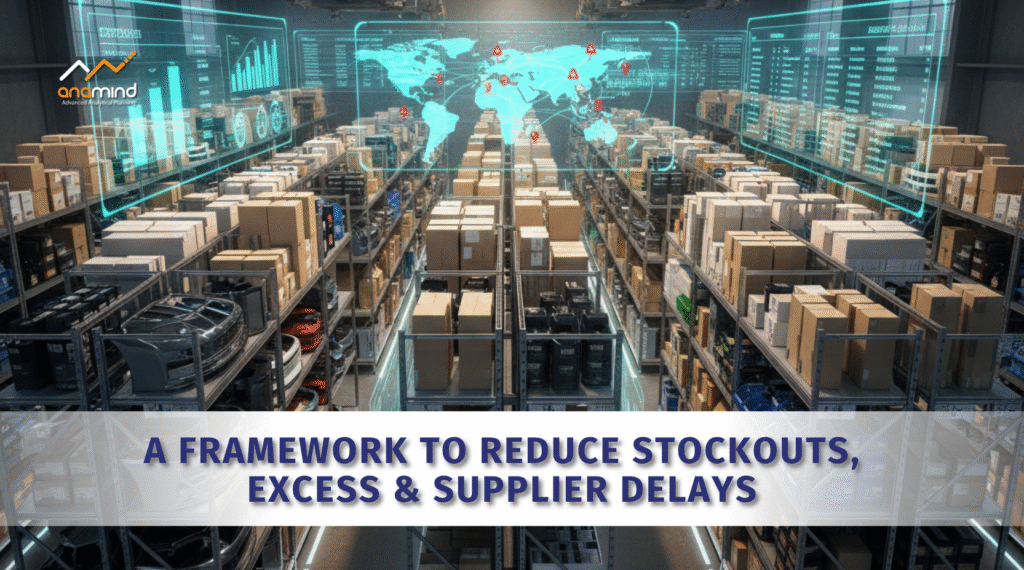If you are managing a pharmaceutical supply chain in 2025, you are navigating a “perfect storm.”
Between the looming November 2025 DSCSA compliance deadline, rising tariffs on imported APIs, and the explosion of cold-chain requirements for biologics, the margin for error has vanished. The era of managing multi-million dollar drug inventories on Excel spreadsheets isn’t just inefficient anymore—it’s a liability.
At Anamind, we’ve seen firsthand how legacy planning models are buckling under these new pressures. But we’ve also seen the other side. We recently helped a leading North American pharmaceutical manufacturer transform their chaotic supply chain into a lean, compliant powerhouse cutting their inventory by nearly half in just months.
Here is the reality of the market today, and the exact blueprint used to survive it.
The New Rules: Why 2025 is Different
Before we look at the solution, we have to be honest about the problem. Three massive shifts are rewriting the playbook this year:
1. The “Track or Die” Mandate (DSCSA)
The countdown is effectively over. By November 27, 2025, full interoperable tracking at the package level is mandatory for all dispensers and trading partners.
- The Risk: If your digital data doesn’t match your physical product, your shipments will be “quarantined” or rejected outright.
- The Reality: You can no longer separate inventory planning from data compliance. They are now the same thing.
2. The Tariff Squeeze on Margins
New tariffs of up to 25% on machinery and APIs imported from key hubs like China and India are inflating production costs. You cannot afford to hold “safety stock” just because you aren’t sure of your demand. Every unit of excess inventory now carries a significantly higher carrying cost.
3. The Cold Chain Boom
With the rise of cell and gene therapies, logistics have become temperature-critical. Real-time IoT tracking is no longer a luxury; it is a baseline requirement to prevent spoilage and ensure patient safety.
So, how do you stay profitable in this environment? You stop guessing and start optimizing.
We recently partnered with a major North American manufacturer of pharmaceutical and personal care products. Despite being a market leader with a presence in 18 countries, their backend was struggling.
The Challenge
- Bloated Inventory: They were sitting on massive piles of excess stock, tying up millions in working capital.
- Shelf-Life Risks: Managing expiration dates for perishable drugs across different regions was a manual nightmare.
- The “Gut Feeling” Trap: Their purchase orders were largely based on the intuition of individual planners using non-standardized Excel sheets.
The Anamind Solution
We deployed a comprehensive Supply Planning re-engineering project using our Streamline solution, integrated directly with their SAP ERP. We moved them away from manual “ForecastPro” methods to a unified AI-driven system.
The Results (In Just 5 Months)
The transformation was fast and quantifiable:
- 40-50% Reduction in Inventory: Within 4–6 months, the client freed up nearly half of their trapped capital.
- Service Levels Maintained: They slashed stock without missing shipments—actually improving customer service by having the right stock available.
- Full Visibility: The new system provided instant visibility into stockouts and excess inventory, flagging issues before they became crises.
How to Replicate This Success for Your Business
This success wasn’t a fluke. It was a result of applying Anamind’s core methodologies to a complex problem. Here is how you can do the same.
1. Ditch the Spreadsheets for AI
Manual planning cannot account for the variables of 2025. Anamind’s AI & Machine Learning-based forecasting detects hidden trends and corrects outliers in real-time. This allows you to predict demand with precision, ensuring you only order what you need.
Explore Solution: Anamind Demand Planning & Forecasting
2. Integrate Compliance with Planning
To meet the DSCSA 2025 deadline, your inventory data must be impeccable. Our solutions integrate directly with major ERPs (like SAP, Oracle, and Microsoft Dynamics), ensuring that your planning data acts as a “Single Source of Truth”. This prevents the data mismatches that lead to costly shipment quarantines.
3. Optimize for Shelf-Life, Not Just Volume
For pharma, “First-In-First-Out” isn’t enough. You need Expirations Management built into your replenishment logic. Our inventory optimization tools simulate supply chain events to minimize write-offs from expired goods.
Explore Solution: Anamind Inventory Optimization
4. Lack a Team? Use Ours.
Talent gaps are real. If you don’t have an in-house team of data scientists, don’t worry. With our Planning-as-a-Service model, Anamind’s experts act as your extended planning arm, using our best-in-class algorithms to manage your supply chain for you.
The Bottom Line
The year 2025 will separate the agile from the obsolete. The companies that continue to rely on manual inputs and “safety stock” buffers will be crushed by compliance costs and tariffs. The ones that pivot to data-driven, automated planning will thrive.
Don’t let your working capital rot in a warehouse.
Ready to future-proof your supply chain?
See how much capital you can unlock today. 👉 Schedule a Demo with Anamind’s Supply Chain Experts





